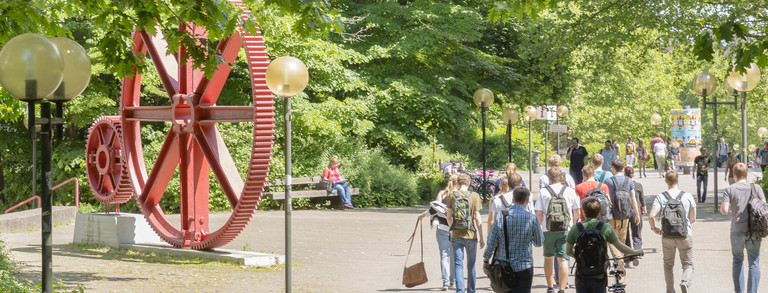Statistical Methods for Data Analysis
The lecture Statistical Methods for Data Analysis is divided into two parts.
Nowadays, data is usually collected electronically in huge amounts. The students learn the appropriate handling of statistical methods for the analysis of moderate to very large amounts of data, oriented to the temporal sequence of a data analysis. The exercises are solved (also) on the computer using common software. In the course, practical and theoretical competence in data analysis is acquired for the preparation of theses and later professional practice.
The course contents include:
SMD A: Numerical methods of data processing, data handling and programming, algorithms and data structures, methods of linear algebra, probability theory, one and multi-dimensional distributions, random numbers and Monte Carlo methods, data mining methods: Discriminant Analysis, Principal Component Analysis, Feature Selection, Supervised Learning (kNN, Decision Trees, Random Forests), MRMR, Unsupervised Learning (Ensemble Learner), Convolutional Neural Nets.
SMD B: Parameter estimation, optimisation problems, least squares method, maximum likelihood method, numerical fit methods, regularisation, confidence intervals and hypothesis testing, parameterisation of data, Bayesian methods, methods for solving inverse problems, validation techniques, treatment of systematic errors, acceptance calculation.
Astroparticle Physics
The students learn contents from the border area between astronomy, nuclear and particle physics and cosmology and their interdisciplinary discussion. They also learn argumentation techniques based on the interaction of theory and experiment. Phenomenological calculations are used to learn how to plan and check the scope of experiments.
The learning contents are:
Cosmic rays: nuclei, electrons, photons, neutrinos, detection of energetic particles, acceleration mechanisms, propagation of particles through the interstellar medium, interaction and decay, galactic magnetic fields, cosmic background radiation, infrared background, cosmological aspects, star and galaxy formation.
Astrophysical sources: Remnants of stellar explosions, compact objects (black holes, neutron stars), shock waves in the ejected stellar envelope, molecular clouds, starburst galaxies, galaxy clusters, supernovae, binary systems, microquasars, nuclei of active galaxies, gamma ray bursts.
Particle physics sources: Spallation, dark matter (WIMPs), topological defects, monopoles, proton decay, axions.
Particle physics measurements: including effective cross sections, energy loss in the medium, neutrino oscillations, physics at highest energies.
Detection instruments: optical telescopes, radio telescopes, air shower systems, gamma-ray telescopes, neutrino telescopes, satellite experiments, low energy detectors.
Practical consequences: biological effects, technological consequences.
Basic Concepts of Physics: From ancient astronomy to modern physics
How do we understand the world? We pursue this question by following the historical development and relating the expectations we place on our explanatory model to the knowledge we have about nature. On the physics side, we look at the development of basic concepts such as time, space, mass, motion, causality, symmetry, probability and quanta from antiquity to the present. It turns out that this development can only be understood in relation to the epistemologies of time. Therefore, the development of epistemologies is presented and discussed in parallel. Since our actions are certainly determined by scientific knowledge, the resulting overall picture is also relevant for understanding political action. In relation to teaching in schools, it is discussed for which teaching topics in physics and philosophy the discussed contents are relevant.
Competences: The students recognise the historical conditions under which our current physical world view has emerged. The emergence of the basic concepts in which the physical world view is formulated (space, time, matter, causality, fields, probability, quanta, etc.) is learned. In the interdisciplinary border area between physics and philosophy (epistemology, philosophy of science), this historical context is used to show how physical research can be justified and how physical theories are established and tested. Pedagogical aspects and connotations are conveyed for possible later teaching of the students at schools or universities. The aim of the course is to teach a competent and critical approach to research justification and research development.
This lecture was developed in close cooperation with the Chair of Theoretical Philosophy, Prof. Dr. Dr. Brigitte Falkenburg, and held jointly over many years. It is therefore explicitly recognised as a philosophical achievement in the philosophy curriculum. It is also heard as a physics elective in other degree programmes.

![[Translate to English:] [Translate to English:]](/storages/app-physik/_processed_/3/a/csm_APPGroupphoto2023_001_small_858e4405eb.jpg)


